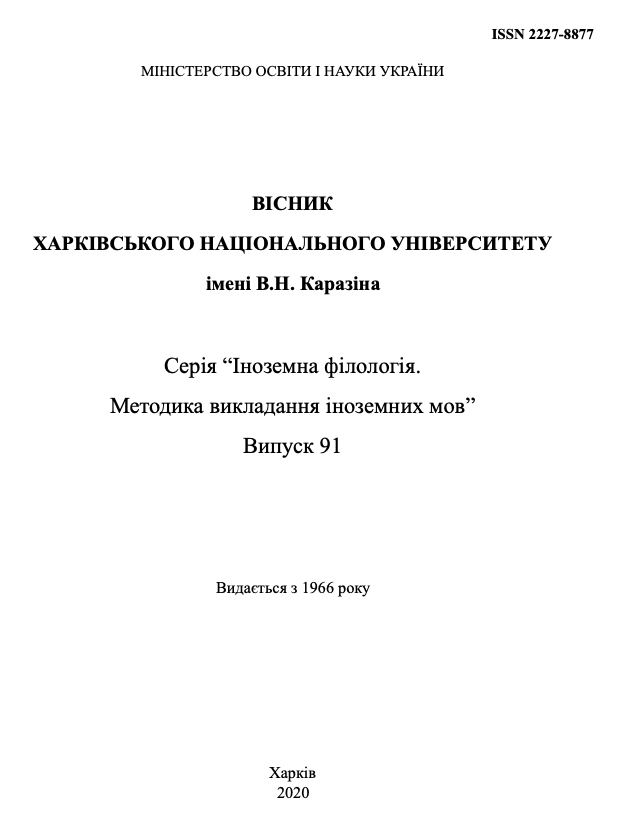Introduction of Synesthetic Metaphors in English-Ukrainian Translations of Fiction
Abstract
Along with the cognitive operations of reconstruction, elimination and substitution of synesthetic metaphors, translational decisions are also based on the cognitive operation of introduction of synesthetic metaphor, which does not exist in the original. The aim of the article is to reveal and describe the cases of introduction of synesthetic metaphors, absent in the original, in the Ukrainian translations of the English text. Synesthetic metaphors are named so, because of the similarity with the phenomenon of synesthesia, which is studied in psychology as the deep interaction of sense organs, in which these organs are "working" together creating a new type of sensibility, named synesthesia. Special feature of such metaphors implies the fact that in contrast to the conceptual metaphors, in which basic domains are the background for the interpretation of the abstract domains, in synesthetic metaphors both source domain/concept and target domain/concept are basic ones, embedded directly into the bodily sensations. Understanding domain we follow R. Langacker, as a concept or conceptual complex of any degree complexity, containing background information, and helping to understand the meaning of the language unit, actualized in the discourse; in other words domains are the background knowledge (basis) for the distinguishing (profiling) of concepts. Domains are distinguished into basic and abstract. Conceptual metaphor we interpred following G. Lakoff, M. Johnsons and Z. Kovecses as the result of the cognitive operation of mapping or projecting, in which abstract conceptual structure (target domain/concept) is identified in terms of concrete (embedded in our bodily experience) mental structure (source domain/concept). Application of methodological tools of conceptual metaphor theory made it possible to reveal synesthetic metaphors, introduced in the translation, based on the following cognitive models: VISION is TOUCH (SENSATION of SHARP SURFACE), HEARING is TOUCH ( SENSATION of DRY/HOT/SOFT SURFACE). Application of operation of introduction of synesthetic metaphor model helps to reveal in translation communicative sense implied by the author of the original.
Downloads
References
Academichniy tlumachniy slovnyk ukrainskoi movy [Academic dictionary of Ukrainian Language]. Available at: http://sum.in.ua/ (in Ukrainian)
Harris, Dzhoann. (2015). Shokolad [Chocolate]. Translated by Volodymyr Polyakov. Kharkiv : Knyzhkovyj Klub “Klub Simejnogo Dozvil’ya”. (in Ukrainian)
Zhulavska О. О. (2019). Vidtvorenia angliskih synesteziinih metaphor sluhovyh vydchuttiv v ukrainskih perekladah [Rendering English Synesthetic Metaphors of Hearing Senses in Ukrainian Translations] // Journal of V.N. Karazin Kharkiv. National Univ. №89. 29–36. (in Ukrainian)
Zhulavska О.О. (2019). Strategii odomashnennia i ochuzhennia v anglo-ukrainskomu perekladi synesteziynih metaphor (na materiali hudozhnogo tekstu) [Foreignizing and Domesticating Strategies in Ukrainian Translations of Synesthetic Metaphors (based on the fiction)]. Science and Education a New Dimension. Philology. VII (62), Issue 211. 70–74. (in Ukrainian).
Martin George. (2012). Pisnia Liodu i plamuniu [A Song of Ice and Fire (A Game of Thrones)]. Translated by Viacheslav Brodovyi. Available at: http://ice-and-fire.in.ua/page/agot/ (in Ukrainian)
Rebriy О. V. (2012) Suchasni koncepcii tvorchosti u perekladi. [Modern concepts of creativity in translation]. Kharkiv : V.N. Karazin Kharkiv. National Univ. (in Ukrainian)
Tartt Donna. (2016). Schchigol [The Goldfinch]. Translated by V. Shovkun. Kharkiv. (in Ukrainian)
Alvarez, A. (1993). On Translating Metaphor. Meta: Translation Journal. 479–490.
Al-Zouibi, M., Al-Ali, M., & Al-Hasnawi, A. (2009). Cogno-CulturL Issues in Translating Metaphors. Perspective: Studies in Translatology. 230–239.
Dagut, M. (1976). Can "Metaphor" Be Translated? Babel. 21-33.
Harris, Joanne. (2007). Chocolate. London: Black Swan. Available at: https://royallib.com/book/Harris_Joanne/Chocolat.html.
Jakobsen, Arnt Lykke, Kristian T. H. Jensen, and Inger M. Mees. (2007). “Comparing Modalities: Idioms as a Case in Point.” In Interpreting Studies and Beyond. A Tribute to Miriam Shlesinger, ed. by Franz Pöchhacker, Arnt Lykke Jakobsen, and Inger M. Mees, Copenhagen: Samfundslitteratur. 217–249.
Kovalenko L., Martynyuk A. (2018). English container metaphors of emotions in Ukrainian translations. Advanced education, Iss. 10, 190–197.
Kövecses, Z. (2002/2010) Metaphor. A Practical Introduction, London/New York: Oxford University Press. 285.
Kovecses, Zoltán, (2014). ‘Conceptual metaphor theory and the nature of difficulties in metaphor translation’, in Donna R. Miller; Enrico Monti (eds) Tradurre Figure / Translating Figurative Language, Quaderni del Centro di Studi Linguistico-Culturali, Atti di Convegni CeSLiC – 3, Bologna: AMSActa, 25–41.
Kussmaul, Paul. (2000). Kreatives Übersetzen. Tübingen: Stauffenburg.
Lakoff, G., & Turner, M. (1989). More Than Cool Reason: A field Guide To poetic Metaphor. Chicago and London: University of Chicago Press.
Lakoff, George, Johnson, Mark, (1980). Metaphors We Live By. University of Chicago Press, Chicago.
Lakoff, G. (1993). ‘The contemporary theory of metaphor’, In A. Ortony (ed.), Metaphor and Thought, Cambridge: Cambridge University Press. 202–251.
Langacker, R. (1987) Foundations of Cognitive Grammar, vol. 1, Stanford, CA: Stanford University Press.
Larson, M. L. (1998). Meaning Based Translation: A Guide to Cross Language Equivalence. Lanham: University Press of America.
Longman dictionary of Contemporary English. (2005). Pearson Education Ltd. Third Edition. Harlow Essex : Longman.
Mandelblit, N. (1995). The Cognitive View of Metaphor and Its Impliction for Translation Theory. Translationa and meaning. 482–495.
Martikainen, Kati. (1999). What Happens to Metaphorical Expressions Relating to ‘Comprehension’in the Processes and Products of Translation? A Think-Aloud Protocol Study. A Pro Gradu thesis, Savonlinna School of Translation Studies. University of Savonlinna.
Martin, George R. R. (1996). A Song of Ice and Fire (A Game of Thrones). New York: Bantam Books. Available at: https://royallib.com/book/R_Martin_George /a_game_of_thrones.html.
Newmark, P. (1988). Approaches to Translation. New York and London: Prentice Hall.
Newmark, P. (1995). A textbook of Translation. New York and London: Prentice Hall.
Oxford Dictionary and Thesaurus. (2007). Oxford University Press. Oxford.
Schäffner, Christina. (1997). Metaphor and Interdisciplinary Analysis. Journal of Area Studies 11, 57–72.
Schäffner, Christina, Schuttelworth, Mark. (2015). Metaphor in translation. Possibilities for process research. John Benjamins Publishing Company, 95–109.
Tartt D. 2013. The Goldfinch. Little, Brown and Company, New York.
Tirkkonen-Condit, Sonja, Jääskeläinen, Riitta, (Eds.) (2000). Tapping and Mapping the Processes of Translation and Interpreting. John Benjamins, Amsterdam and Philadelphia. 53–68.
Tirkkonen-Condit, Sonja. (2001). “Metaphors in Translation Processes and Products.” Quaderns. Revista de traducció 6. 11–15.
Tirkkonen-Condit, Sonja. (2002). “Metaphoric Expressions in Translation Processes.” Across Languages and Cultures 3 (1). 101–116.
Van Den Broeck, R. (1981). The Limits of Translatability: Exemplified by Metaphor Translation. Poetics Today: Translation Theory and Intercultural Relations, 73–87.




